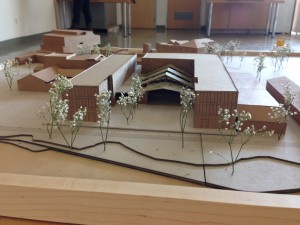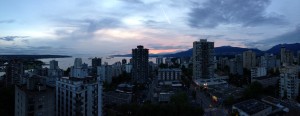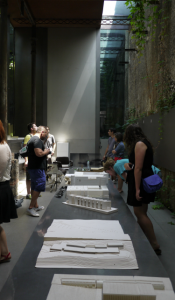 The program that I attended during my time last summer in Barcelona, Spain was an immersive 7 credit urban design and media course. It was an intense 6 week experience that combined architectural drawing and media with history of urban design, and culminated in a 2 week research project that used the city streets as our laboratory. Drawing and diagramming by hand was the first skill set we practiced. Every day was a physical journey through the city’s history, beginning with medieval old walled city’s winding stone streets and cavernous passageways. We learned to quickly draw the essence of a public space by watching the movement of people, the placement of street furniture such as benches and the layout of streets. For a group of architecture students, mostly used to drawing the ornamentation of buildings and shapes of spaces, this was a whole new way of understanding a place. Some of us experimented with photo collage, and watercolor, while others preferred new media such as 3D modeling programs. By working in teams, we were able to learn from each other across disciplines, and experience levels.
The program that I attended during my time last summer in Barcelona, Spain was an immersive 7 credit urban design and media course. It was an intense 6 week experience that combined architectural drawing and media with history of urban design, and culminated in a 2 week research project that used the city streets as our laboratory. Drawing and diagramming by hand was the first skill set we practiced. Every day was a physical journey through the city’s history, beginning with medieval old walled city’s winding stone streets and cavernous passageways. We learned to quickly draw the essence of a public space by watching the movement of people, the placement of street furniture such as benches and the layout of streets. For a group of architecture students, mostly used to drawing the ornamentation of buildings and shapes of spaces, this was a whole new way of understanding a place. Some of us experimented with photo collage, and watercolor, while others preferred new media such as 3D modeling programs. By working in teams, we were able to learn from each other across disciplines, and experience levels.
The next phase of the course took us to the expansion of the city beyond the medieval walls, with and organized, rigorous grid of streets and chamfered corner blocks. Spacious open streets and tree lined shopping ‘ramblas,’ or pedestrian avenues, felt grand and regal. Finally, we studied the expansion of the city in preparation for the 1992 olympics, and the subsequent redevelopment of a formerly industrial zone into a high-tech reinvestment area known as the 22@ district. Many of these buildings and public spaces were architectural showpieces for the city, and featured experimental façade systems and program elements.
 By experiencing each of these periods of history firsthand, and recording them via urban design diagrams, we were able to feel the layers of history that make up the many vibrant neighborhoods of Barcelona. When it was time to create an urban design intervention of our own, during the final phase of the program, we had a more thorough understanding of the place, and the values of its people. When we presented our final work to professors of the local architecture school, city officials, and local professional designers, they noted how in tune we were with the needs and aesthetic styles of the place, despite how recently we had arrived.
By experiencing each of these periods of history firsthand, and recording them via urban design diagrams, we were able to feel the layers of history that make up the many vibrant neighborhoods of Barcelona. When it was time to create an urban design intervention of our own, during the final phase of the program, we had a more thorough understanding of the place, and the values of its people. When we presented our final work to professors of the local architecture school, city officials, and local professional designers, they noted how in tune we were with the needs and aesthetic styles of the place, despite how recently we had arrived.
In conclusion, this immersive program was a great kickstart to my current interest in urban design, and gave me a whole new lens with which I see cities, and a totally unique learning experience that I couldn’t have gotten anywhere else!
– Annie Ledbury, Life/City/Adaptation in Barcelona
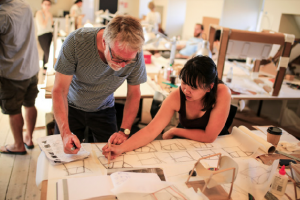 The greatest highlight of my time in Copenhagen, Denmark was designing and building a veneer chair with the most skilled craftsmen and teachers in Scandinavia. Part of this course with the Danish Institute for Study Abroad involved a study tour to Sweden and Finland to study furniture of Scandinavia. I got to study the works of the greats: Wegner, Juhl, and Aalto. I learned the cultural significances and principles of Danish design which involves making good design accessible to the masses, staying honest with materials, and being well-crafted.With these principles in mind, we designed (for about 4 weeks) and built (in a period of 2 weeks) our own chairs. The first four weeks were made up of mostly guest lectures from design professionals and academics. We visited many museums, showrooms, and manufacturing facilities. We also sat in, examined, measured, and sketched out many chairs. We learned how to create visual journals out of our sketchbooks, which meant drawing things that are not obviously seen. My instructor Erling Christoffersen is a Danish furniture designer who was an amazing, supportive, and helpful figure in the entire process. The instructional assistants Gudmundur and Clinton were also exceptional teachers who made sure our questions were always answered. All the faculty at DIS were extremely supportive and helpful through our design and building processes.
The greatest highlight of my time in Copenhagen, Denmark was designing and building a veneer chair with the most skilled craftsmen and teachers in Scandinavia. Part of this course with the Danish Institute for Study Abroad involved a study tour to Sweden and Finland to study furniture of Scandinavia. I got to study the works of the greats: Wegner, Juhl, and Aalto. I learned the cultural significances and principles of Danish design which involves making good design accessible to the masses, staying honest with materials, and being well-crafted.With these principles in mind, we designed (for about 4 weeks) and built (in a period of 2 weeks) our own chairs. The first four weeks were made up of mostly guest lectures from design professionals and academics. We visited many museums, showrooms, and manufacturing facilities. We also sat in, examined, measured, and sketched out many chairs. We learned how to create visual journals out of our sketchbooks, which meant drawing things that are not obviously seen. My instructor Erling Christoffersen is a Danish furniture designer who was an amazing, supportive, and helpful figure in the entire process. The instructional assistants Gudmundur and Clinton were also exceptional teachers who made sure our questions were always answered. All the faculty at DIS were extremely supportive and helpful through our design and building processes. 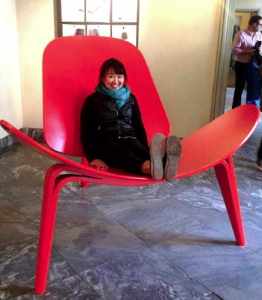

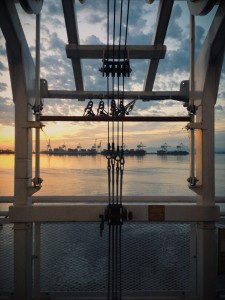 was not only able to participate in the program that brought me to the University of Oregon, but it has been the highlight of my graduate school career thus far.
was not only able to participate in the program that brought me to the University of Oregon, but it has been the highlight of my graduate school career thus far.